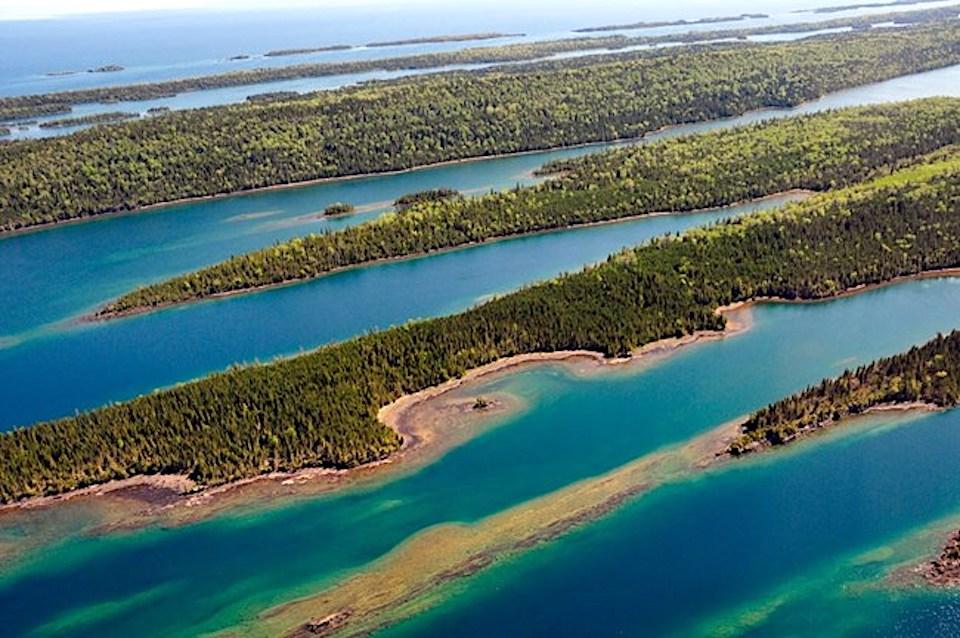
Up to six more wolves could be moved to Isle Royale National Park this weekend/NPS
If weather allows, up to six more wolves could be moved to Isle Royale National Park this weekend, as an effort is underway to relocate six wolves from Michipicoten Island that are in danger of starving to the national park.
Staff at the National Parks of Lake Superior Foundation said Thursday that they were working with the International Wolf Center to see the relocation happen.
Four to six wolves still remain on the island, which is in the Ontario, Canada, section of Lake Superior, and are at risk since their only available winter prey on the island, caribou, are gone, the foundation said in a release. Officials had hoped to move all of the wolves off Michipicoten earlier, but poor weather, government shutdowns, and a lack of funding delayed that effort.
The foundation and the International Wolf Center see the relocation as having "a more immediate impact on the current burgeoning moose population on Isle Royale, where an estimate of more than 1,600 moose are threatening the ecosystem."
"On Michipicoten, nature's lessons can be cruel and starvation is one of them,” said Sona Mehring, the chair of the Foundation. “For the remaining wolves on Michipicoten, that will be their fate unless we help move them to Isle Royale National Park, where their hunting skills and genetics can add value to establishing a new population of wolves on Isle Royale.”
Isle Royale wolves have been in decline for more than a decade, due to chronic inbreeding. There was hope that "ice bridges" that formed between the Lake Superior island and the Canadian mainland during the winter of 2013-14 would enable wolves to arrive from Canada with new genes. But no new wolves reached the island, while one female left and was killed by a gunshot wound in February 2014 near Grand Portage National Monument.
In recent years, park managers have discussed wolf management on 209-square-mile Isle Royale with wildlife managers and geneticists from across the United States and Canada, and have received input during public meetings and from Native American tribes of the area. Those discussions examined the question of whether wolves should be physically transported to Isle Royale, in large part due to concerns that a loss of the predators would lead to a boom in the moose population that likely would over-browse island vegetation.
Under the plan the National Park Service adopted last year year, up to 30 wolves are to be set free at Isle Royale over the next three years in a bid to build genetic diversity into the park's wolf packs.
In late February, the Ontario Ministry of Natural Resources and Forestry successfully transferred four wolves to Isle Royale. If this weekend's effort to move the six wolves succeeds, the number of predators relocated to the park since last fall would stand at 12. Eight previously had been moved there -- four in the fall, and four this winter -- but one died from pneumonia soon after being released and another left the park via ice bridge last month and headed to Minnesota where she had been captured.
“We’re especially proud of the fact that the International Wolf Center is helping to save the lives of a small pack of wolves on Michipicoten Island,” said the Center’s Executive Director Rob Schultz. “Since all of the caribou have been removed from Michipicoten, there’s nothing left for the wolves there to eat this winter and there is a real threat of starvation.”
It is estimated that the four-day effort, which will begin either Friday or Saturday, will cost $100,000. The Foundation raised $30,000. The International Wolf Center raised an additional $45,000. The organizations have started a GoFundMe page to raise the final $25,000.
"As we discussed this project, we found many people who supported seeing the forests of Isle Royale remaining healthy,” Mehring said. “We are close to realizing the goal of providing another capture opportunity to move these iconic wolves to an island that needs them in its ecosystem.”
Schultz said a healthy wolf population at Isle Royale would greatly benefit the island's ecosystem.
“If left unchecked, moose would over-consume the island’s vegetation. Apex predators, like wolves, are important components of any healthy, natural ecosystems," he said.



Comments
It seems to me that the most efficient and least expensive way to help reduce moose populatio on Isle Royale would be to hold cow moose hunts. This also would have raised revenue. Why would they add wolves to the island when the previous experiment showed wolves eventually die out? Very short memories!